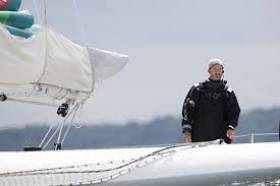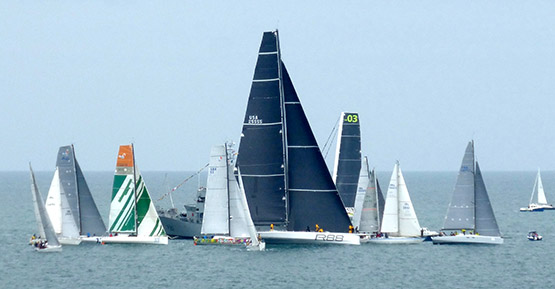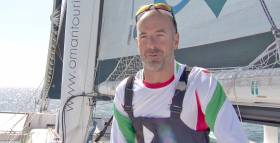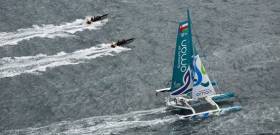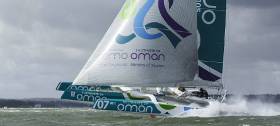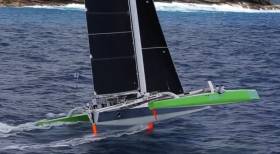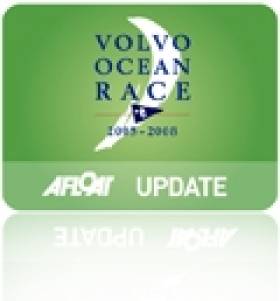Displaying items by tag: Damian Foxall
When three MOD 70s swept through the starting line at Wicklow on Saturday June 18th for the Volvo Round Ireland Race, so much work behind the scenes had gone into bringing this very special trio to Ireland’s premier offshore racing event that it would be easy to forget that the first seeds of this remarkable lineup were planted some years ago by our own sailing superstar, Damian Foxall of Derrynane in County Kerry.
Thanks to his rising status in the high-powered French multi-hull scene, Foxall was able to bring the challenge of the Round Ireland Record up their agenda, and at every possible opportunity, he encouraged his most regular multi-hull skipper, Sidney Gavignet with Musandam-Oman, to slot the possibility of a Round Ireland sprint into the busy annual schedule.
Foxall’s powers of persuasion must be really remarkable, for it was after no less than three attempts, when the challenges were called off as the weather failed to develop as expected, that Gavignet finally cracked it at the beginning of May 2015.
But by a cruel irony, Damian Foxall wasn’t on board, as he had been pre-booked to fill a key role in a Volvo World Racer. Thus the Round Ireland remained unfinished business in the Foxall CV, while other MOD sailors reckoned that Gavignet’s new time was beatable.
With this new consciousness burgeoning about the Round Ireland challenge, as soon as Wicklow SC confirmed there would be a proper multihull division in 2016 race, the MOD 70 wheels started turning. But few would have been so optimistic as to predict that three of these magic machines would turn up in Wicklow, and even fewer would have predicted that all three would blow away Musadnam-Oman’s 2015 time.
To make the fantasy nature of it complete, it emerged that neither Damian Foxall who was sailing on Musandam-Oman, nor Justin Slattery who was aboard Phaedo 3, had any experience of doing this long-established race from Wicklow round their homeland. They were Round Ireland Virgins, having both been so busy building their careers at the very top level of the international circuit that the Round Ireland had simply never come up on the radar before.
Well, it’s very much on the radar now, after the race of a lifetime. For much of it, Ned Collier Wakefield with Team Concise led narrowly from Phaedo 3, with Musandam-Oman spending rather more time in third slot than her supporters might have liked. But in the final dozen miles, it started to come right, and perfectly called tactics saw her take the first place in style as dawn began to break on the Monday. Damian Foxall is very deservedly one of the winners of an Afloat.ie International Sailor of the Month Award for June 2016.
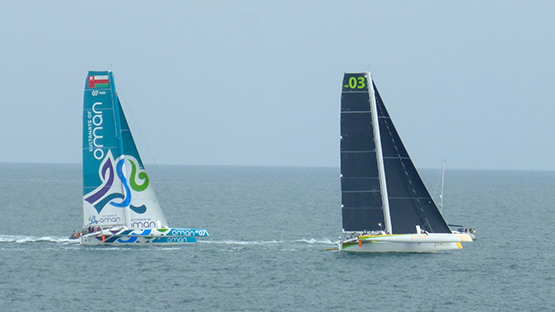
At 704 miles long, with a course along coastlines of almost infinite variety, the Round Ireland Race was always a complex event for post-race analysis even when fleets amounted to only three dozen or so. But for 2016 in the first year of sponsorship by Volvo Car Ireland, the number of starters soared to 63. And the inclusion of multi-hulls for the first time since the initial pre-RORC race of 1980 added further depth to the eclectic nature of the fleet, which was already an extensive array, as it ranged from small craft like a J/97, a First 31.7 and a Sunfast 3200, to one of the current superstars of world sailing, George David’s Juan K-designed canting-keeled Rambler 88. Having provided us with 17 up-dates during the six days of the race, W M Nixon takes a final overview.
Here’s to Yellowbrick, the friend of armchair sailors everywhere. In the old days, trying to analyse or explain the unfolding story of the biennial Round Ireland Race was a formidable challenge. And you could be talking about it to people very few of whom had ever sailed round Ireland, while others didn’t even know it from the land, as they have been availing of sunshine holidays ever since cheap air travel arrived.
Thus there are many who know more of the coasts of Spain, Portugal and Greece – or even the Scottish Hebrides and the Isles of Scilly - than they do of Mayo and Donegal. And having experienced both those Irish counties in their more perverse meteorological moods in the course of several races round Ireland - not to mention many non-racing cruising circuits – I have to admit that I can see their point of view.
The Yellowbrick tracker for the Volvo Round Ireland Race 2016 wraps Ireland in its web. TriLogic went furthest east after the start, the three MOD 70s went furthest south off the south coast and furthest west off the west coast, Rambler 88 went furthest northwest, and Pegasus of Northumberland went to the Isle of Man but came back to cross tacks yet again with Teasing Machine, this time at Skerries as the Machine came south from Dundalk Bay.
"Round Ireland 2016 is in a special league of its own"
Yet the round Ireland race is addictive, and for those who have done it in the past, particularly those who have done it several times, it’s a bit of a pang to see the fleet go off and not be part of it. Even with all the modern equipment and boats which are obviously faster, it’s still a very worthy challenge. And it induces a special post-race camaraderie among crews who, in racing terms, have been at each other’s throats since the start.
After each biennial staging, something new has always turned up to add to the sailing history books. But the Volvo Round Ireland Race 2016 is in a special league of its own in this category, so much so that far from just adding something to the history books, it probably deserves a book of its own.
In fact, you could write a book about the fantastic start in which Rambler 88 gave a Masterclass in discerning emerging gaps beginning to appear in a melee of sometimes confused smaller bats. Despite her huge beam she came cleanly through to a peach of a start right on the committee vessel LE Aisling, bettered only by Eric de Turckheim’s A13 Teasing Machine while smaller craft which thought they’d done better found they’d been OCS, which led to a slow and painful return against a strengthening ebb to re-start.
Rambler’s miraculous start, finding gaps where none had existed ten seconds earlier. Photo: W M Nixon
Fortunately in making some sense of what happened afterwards, we can take a precise positional overview by looking at the Yellowbrick tracking as it was at virtual completion yesterday afternoon. It may look like a right cat’s cradle of lines all eventually getting back to Wicklow, but there are stories to be drawn from every part of it.
In the first beat from Wicklow Head down to the Tuskar Rock, very few boats tended to the east, and it certainly didn’t pay off. The one who went furthest east was the 50ft Trilogic, Hugo Carlsson-Smythe’s trimaran, which ultimately retired during the course of the race with gear and sail problem, so we don’t know if ultimately she would have overcome this initial tactical error.
The mono-hull which tacked furthest east was Chris & Patanne Power Smith’s J/122 Aurelia (RStGYC), but she then put in a good showing in the long beat along the south coast and got herself back in the hunt, although off the north and east coasts things didn’t go quite so well, but in the end she placed 3rd in IRC 2 and 18th in IRC overall.
"Teasing Machine made a proper job of tide-dodging"
While the bulk of the fleet were still struggling against foul tides down the Wexford coast with Teasing Machine showing how to make a proper job of tide-dodging inside the Wexford banks, out ahead the biggies were splitting into their two parts of this fleet of four parts.
Although the reckoning was that conditions might just fall the right way for a new record, the three MOD 70s first had to find a breeze to raise them above the 12 knots which they occasionally fell back to as they came on starboard out past the Coningbeg Light. Thus it’s Musandam-Oman, Phaedo and Concise which are those three tracks which go way to the south. As they were so close to each other in performance, they sailed as a pack, so there was an element of covering as much as strategy in this, but in these early stages it was Ned Colllier Wakefield aboard Concise who was making the pace, with Phaedo next in line, while Musandam seemed to find it difficult to obtain quite the same speed.

The first hint of light in the east in the sky as the MOD 70 Musandam-Oman closes in on the Wicklow finish for a last-minute takeover of the line honours lead on the water, after her sister-ship Team Concise had led for most of the race. Photo: Mark Lloyd
Perhaps Irish sailing superstar Damian Foxall aboard Musadnam was slightly over-awed by it all, as he hadn’t been aboard Musandam when she set the new open Round Ireland record back in May 2015, and in an interview before the race (see below), he revealed that he and Justin Slattery – who was on Lloyd Thornburg’s Phaedo - were both Round Ireland virgins. They’ve been so busy building their international careers in other parts of the world that racing round their home island had never come up on the radar.
Whatever the reason, it was Concise which was least fazed by the challenge, she stayed closely in the lead, and after they’d tacked and started ripping up the west coast in the rising sou’west winds of Sunday, it was Concise which recorded the MOD 70’s best speed of 41.56 knots. But as they admitted afterwards, they weren’t right on the edge when they his that mega-speed in a growing Atlantic swell – they were beyond it.

Just outside a two day elapsed time, George David's Rambler looked every inch a winner in her debut Round Ireland race. Photo: Afloat.ie
After her glorious start ten minutes ahead of the MOD 70s, Rambler was going so well in the moderate southerly that she was past Arklow before the trimarans came through, but soon they’d disappeared ahead, and thus for the reminder of the race Rambler 88 was entirely on her own, thereby providing Part 2 of our four part round Ireland fleet. Although she’d been holding the IRC overall lead for a while, at various stages she’d dropped back as smaller craft got clear of foul tides. But once she was past the Fastnet and beginning to build her speed up the west coast in rising breezes, she was soon featuring among the front runners on all counts.
If anything, the weather felt almost Autumnal off the west coast, it had seemed slightly spring-like as warmer weather spread in while the leading big boats were far at sea seeking breezes off the south coast, and there was decent sunshine while the larger boats of the fleet were shuttling from Dun Laoghaire down to Wicklow on the Saturday morning for the start. But on the Thursday night in Dun Laoghaire when it was open house at the Royal Irish YC to meet the heavy hitters, a local weather anomaly was giving a temperature of 9 degrees Celsius which had been winter by anyone’s standards, it was certainly experienced but fortunately it wasn’t to occur again.
With the leading big boats zapping up the west coast on Sunday as south to sou’west winds continued to freshen, records were once again top of the agenda. But this was all of academic interest to the main part of the fleet bashing its way along the south coast, for as Sunday went on, conditions became increasingly rugged. Yet it was not without its local oddities – for a period on Sunday afternoon, there was very little wind indeed in an area close in on the entrance to Cork Harbour, and the spread of breeze was so uneven that the tracker revealed some boats taking rather desperate gambles to try and find steadier conditions.

Mark Mansfield and Maurice “The Prof” O’Connell on Dave Cullen's J109 Euro Car Parks, the IRC3 winners. Photo: Afloat.ie
One boat which did notably well during this stage was Dave Cullen’s J/109 Euro Car Parks. With Corkmen Mark Mansfield and Maurice “The Prof” O’Connell calling the shots, they gave a masterful demonstration of how to work the bays slugging west beyond the Old Head of Kinsale.
“Working the bays” doesn’t necessarily always pay off, and in fact it didn’t work so well for other boats near Euro Car Parks. So clearly an important factor in the successful use of this ploy is to have a boat which is out-sailing everyone else in any case, and it was noticeable by this stage that Euro Car Parks had worked out a formidable lead on all the other J/109s while she herself was in hot pursuit of Paul O’Higgins new JPK 10.80 Rockabill VI, racing with the noted talents of Mark Pettit and Brian Mathews on board.
"Rockabill VI was a very slippy performer"
As Sunday evening and night went on, the Fastnet became increasingly difficult to get past as the area of steadier fresher breeze moved to the north. Thus while bigger boats such as Alan Hannon’s Reichel-Pugh 45 was making hay up past the Blaskets with a performance which suggested that she a going better and better as her Lough Swilly YC crew became accustomed to her ways, back down the line off the mouths of the great rias of the southwest at times the wind was all over the place, and Euro Car Parks was one which suffered, head off south of Dursey Dound, and forced to tack seaward in unspeakably lumpy sailing conditions.
By this time Rockabill VI was showing she was a very slippy performer, and the long run up the west coast was brilliantly sailed by her talented crew, so much so that by Tory Island she’d opened out a lead of 40 miles on Euro Car Parks, which looked unassailable.
But for others even thinking about Tory Island was still way off the radar, as many boats reckoned they’d taken a ferocious battering through the latter part of Sunday, and there were retirals at all levels of the fleet. Meanwhile away to the east the oldest boat in the race, Darryl Hughes’s 1937 Tyrell of Arklow 43ft–gaff ketch Maybird was making only very slow progress and she’d sustained damage aloft and to sails, so she went into Dunmore East and kept the crew strictly on board and out of contact with the shore while they made repairs and then, most gallantly, they put to sea again and eventually after another two days of slow progress to windward they had the freeing of sheets at Mizen Head within sight, but then it was discovered that there was a major problem with the engine, so they retired regretfully into Baltimore.
By this time the great dramas of the record finishes at Wicklow had been played out through Monday. So long as there’s breeze your ordinary North Channel fair or foul tides aren’t the major consideration for he MOD 70s, it’s the presence of wind which is the primary consideration.
Sunday evening found the MOD 70s shaping themselves into the North Channel and fetching through with all still close together and Concise still just leading, but from the South Rock on it was hard on the wind or beating to get to Wicklow. Musandam was still trailing the other two, so she took a brief slant towards Dundalk Bay and then went on to starboard to pace with them about two mioles further westward, bringing her in closer to Howth than Concise or Phaedo, and putting her in a better breeze as the wind started to play tricks in the dark of the small hours off Bray.
Everything was gettingly nail-bitingly tense, and south of Greystones, Phaedo and Concise were slowing markedly, so Musandam came up from astern and took a bit of an offing, finding better breeze only a short distance offshore which carried her right to the line at Wicklow to finish ahead and created an absurd new record of 1 day 14 hours and 37 minutes, with Phaedo 3 six minutes astern, and Concise – which had so gallantly led for most of the race – coming in another minute later.
Follow that, as they say, but somehow Rambler 88 managed to outdo the drama, as she did the final stage from Rathlin Island to Wicklow in just part of the one span of daylight on Monday. But by the time she came calling the wind had veered and thus she was able to lay the whole way down the Irish Sea to the finish, and was travelling at full chat as she came into the line.
While a mono-hull record within two days was no longer possible as she’d sailed 790 miles in all thanks to that long tack to the south in search of better breeze through Saturday night and Sunday morning, nevertheless she still made an almighty dent in every other mono-hull record by finishing in a time of 2 days 2 hours 24 minute and 9 seconds.
There was still some bite to the winds, but even in a poor summer such as we’re currently experiencing, the fact that the sou’west to west breeze had now been blowing moderate to strong and more for more than three days was increasing the likelihood of calm patches, and a general falling away in wind strength.
So gradually the crazy notion took hold that not only would the popular Rambler 88 be lauded as the new all-out mono-hull record holder, but she might even manage to win the race on corrected time. Certainly the holes in the wind now began to appear with increasing frequency, and none more so than for Rockabill VI as she rounded Inishtrahull, the most northerly point of the course, on Tuesday.

Rockabill VI – a new JPK 10.80 design. Photo: Afloat.ie
The O’Higgins crew came up against what was soon known as the Great Glass Wall of Inishtrahull. Rockabill and the three other boats in her immediate neighbourhood all came to such a complete halt that tracker-followers assumed they must all have fouled lobster pots. But they were simply and totally becalmed. They made no progress for three hours, yet boats close to the east were still bustling busily towards Rathlin Island, while boats close to the west were trundling merrily in from Tory.
So after the episodes of winter and spring and autumn, Rockabill was experiencing a brief bit of summer she could have well done without. Finally she got going again, but by this time Euro Car Parks had sliced a huge 20 miles out of Rockabill’s 40 mile lead, and thereafter it was Euro Car Parks ahead in IRC 3 on corrected time. In other classes, solid performances and reliability in strong winds had been rewarded, and in IR2 the beautifully-prepared Cornish-based Swan 47 Sarabande (Rob Mabley) had a lead she held to the finish, while in IRC 4 we were witnessing one of the great performances in the race, with Patrice Carpentier’s Sunfast 3200 GROUPE V tenaciously staying in front throughout, quite a showing as she was also leading the two-handed division.
As the race drew to a close through Wednesday and Thursday for this main part of the fleet, other consistent performances were being rewarded. Eric de Turckheim’s Teasing Machine was both consistent and brilliant, and on Wednesday tacking down the southern part of the North Channel, she was neck and neck with Ross Hobson’s two-handed canting-keeled Open 50 Pegasus of Northumberland.

French entry Teasing Machine was both consistent and brilliant. Photo: Afloat.ie
But while Pegasus elected to continue on starboard right over to the Isle of Man as can be seen on the tracker plan, Teasing Machine’s crew took a completely different choice, they went right to the southwest, and then tacked to curve across Dundalk Bay close past Clogher Head until the two boats met again at Rockabill, following which they paced together down to Wicklow where a bit of slick tacking saw Teasing Machine finish ahead, but by this time it was akin to bear-baiting, as the crew of the big Pegasus were boggle-eyed with exhaustion.
Teasing Machine’s time put her behind Rambler 88 on corrected, so the crazy dream was becoming reality, but that is in no way to detract from the de Turkheim crew’s performance, it was a superb playing of the hand they’d been dealt, They were comfortably ahead of Class 1 and 2, and soon out of sight on the determined little battlers of Classes 3 and 4, who until then had been snapping at their heels.
Meanwhile, between the big’ uns well finished, and the little’ uns still battling far at sea, there were several Steady Eddy performances whose reward was on its way, and none more so than for RORC Commodore Michael Boyd of the Royal Irish YC. His Fist 44.7 Lise was always there or thereabouts, and on Wednesday evening she was off Dublin Bay as the tide turned foul, but she kept beating on steadily towards Wicklow and got finished before midnight with the bonus of a local breeze, and was immediately sitting pretty at second in Class I well ahead of Katsu in third, and looking good for third overall behind Rambler and Teasing Machine.
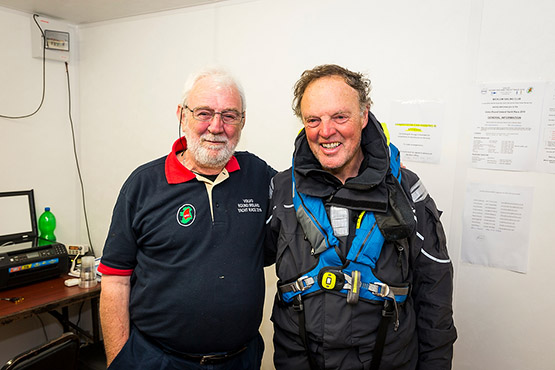
Midnight encounter. Race organiser Theo Phelan with RORC Commodore Michael Boyd after the latter had brought the First 44.7 Lisa across the Wicklow finish line to take third overall. Photo: David Branigan
But that third overall needed a bit of waiting, as the Class 3 front-runners of Euro Car Parks and Rockabill VI were still in with a chance, while Class 4’s GROUPE V and Stephen Quinn’s gallant little J/97 Lambay Rules were also in contention, but it was not to be. The minutes slipped away, the hours ticked by, and in the end over a course of 704 miles it was waterline length which counted as a fading breeze and much windward work saw the little ‘uns lose out. But my word, they had one impressive race amongst themselves.
The results are still being analysed as we write this, and it was only on the Friday that Rambler was finally confirmed as overall winner, with Teasing Machine second and Lisa Third. As for Class winners, they were (1) Teasing Machine, (2) Sarabande, (3) Euro Car Parks, and (4) GROUPE V, but GROUPE V lost her two-handed class lead to Begian Michael Kleinjans’ Open 40 Roaring Forty 2 which was another steady performer.
"All credit to Wicklow Sailing Club’s Theo Phelan and his team"
In all, it was a wonderful race, a magnificent sporting event from which any keen sailor can take much of interest and even more of entertainment and excitement. All credit to Wicklow Sailing Club’s Theo Phelan and his team who have kept this event going through the thin times, and have been ready and waiting to see it come to a new flowering with sponsorship from Volvo Car Ireland.
But all the background organization would have been meaningless without a fleet of boats and their crews game to take on the 704-mile circuit of an island set in an exposed location on the lee side of the Atlantic ocean, and in following this race it has been particularly encouraging to see the improving performances of certain boats as their relatively novice crews get to grips with the challenge they’ve taken on. Needless to say it was also a case of the Old Dog for the Long Road, and Ian Hickey’s Granada 38 Cavatina was again in the frame at the fiish in Class 4.

Top of the class - a notable performance by the sailing school crew from the INSS in Dun Laoghaire. Photo: Afloat.ie
Notably outstanding was the Irish National Sailing School’s Reflex 38 Lynx from Dun Laoghaire, skippered by Kenneth Rumball. She was always in competition, but as the race went on she seemed more in competition than ever, until at the finish she clocked in at fourth among all those hotshots in Class 3, close astern of Conor Fogerty’s Sunfast 3600 Bam at third, and placed tenth overall in fleet. The crew of Lynx have had one excellent lesson in offshore racing.

The essential post-race de-briefing – the crews of Euro Car Parks and Rockabill VI, leaders in Class 3, get together in Wicklow SC on Thursday afternoon after five days of racing against each other round Ireland. Photo: W M Nixon
Volvo Round Ireland 2016 selected results
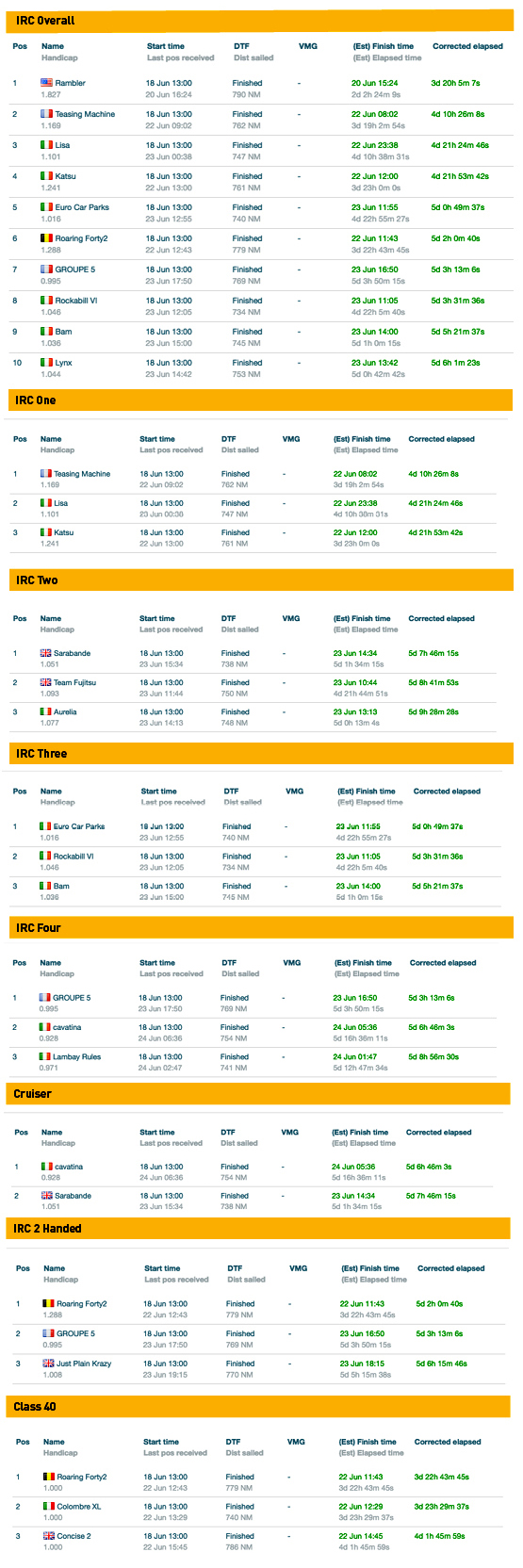
See Round Ireland tracker here Afloat's Round Ireland 2016 coverage is here and download overall results here
Three high speed MOD70s are closing in on the Volvo Round Ireland Race finish line at Wicklow, for what might yet be a record breaking time, early tomorrow morning. In an exclusive pre–start video (below) for Afloat.ie, Digby Fox interviewed County Kerry sailor Damian Foxall onboard Round Ireland record holder Musandam Oman, currently off Rathlin Island.
In this video, Foxall, a Volvo Ocean Race winner, who has sailed eight round the world races, reveals he has never sailed Round Ireland! And Foxall's crew–mates, including skipper Sidney Gavignet, give an insight into sailing the fastest boats in the world and the importance of their 2015 record.
See Round Ireland tracker here and keep to up to date with the fleet's progress with Afloat's regular Round Ireland 2016 updates here
The learning curve on the Sultanate of Oman’s flagship MOD70 Musandam-Oman Sail is due for a shift in emphasis in 2016 with their early season programme of the Myth of Malham, the Round Ireland Yacht Race and the Transat Quebec-St Malo races designed to hand Omani crew extra roles and responsibility in the pursuit of success.
Last year, French skipper Sidney Gavignet placed the focus on fitness as they racked up thousands of miles across Europe with a 50% Omani crew, setting a new Round Ireland record plus a new speed record at Kieler Woche 2015.
The stakes have been raised this year and the selection of the three events in May, June and July will help to prepare the Omani sailors for roles at the highest level of offshore racing.
The Myth of Malham at the end of May (28-29) and the Round Ireland Race in June (18) are both organised by the UK’s Royal Ocean Racing Club and offer an opportunity to compete against other MOD70s, explained Gavignet, while the Quebec to St Malo Race is more about adventure and exploration.
“The Quebec to St Malo Race is a classic,” he said. “It is a race I have done three times and it is special. East to west across the Atlantic starting with a 400-mile section down the Saint Lawrence river which is bordered by mountains on both sides. There are lots of whales – including the Beluga Whale – and white beaked and white sided dolphins. In a sailor’s career doing this race is something you will never forget.
“It is more about adventure and the memories. Also it means two transatlantics – one going there and one coming back so it is good training for our Omani crew mates.”
Although Oman Sail and Gavignet have yet to finalise the crew for the season, he is keen to take new offshore talent Raad Al Hadi, who impressed during a recent training run between Lorient and Morocco.
“Raad is good and learning quickly so we will take him from Quebec to St Malo where he will gain experience but he is still a student so we do not plan to take him on the RORC races,” Gavignet said.
Omani sailors Fahad Al Hasni, Sami Al Shukaili, Yassir Al Rahbi will also be back in action along with Irish offshore specialist Damian Foxall and France’s Jean Luc Nelias, who was navigator on Volvo winner Groupama in 2006.
The three Omani sailors have been preparing for their summer by campaigning their J80 at the 2016 Grand Prix Ecole Navale in France having raced together for EFG Sailing Arabia – The Tour in February.
Gavignet’s experience will serve Musandam-Oman Sail well in the Quebec-St Malo but the Myth of Malham, a 230-mile race from Cowes to the famous Eddystone Lighthouse and back, will be a brand new experience for him.
“It is an English classic so we are looking forward to it and would love to win it. We will be up against two other MOD70s which is the main reason why we are doing it but it will be a challenge because the other two boats Phaedo and Team Concise have done a lot of sailing over the last few months.”
Results are important, Gavignet continued but Oman Sail’s objective to develop top class sailors for world class events requires a broader focus.
“We want the guys to take on more responsibility. To be an accomplished offshore sailor, you have to think on your feet and we have some real talent on this crew so I will be working with each crewmember individually to encourage them to take responsibility, perhaps for a winch or for safety or whatever other role they might need to prepare for a major offshore race.”
The remainder of Musandam-Oman Sail’s summer programme will be announced later in the season but according to long standing crew member Fahad Al Hasni, racing against the other MOD70s is the highlight.
“By the end of this programme, we would like to be the leading MOD70,” he said. “It will be a challenge because the boats are all different now and the other crews have done a lot of sailing but our time together as a team on the Farr 30 at EFG Sailing Arabia – The Tour, during our training run from Lorient to Rabat and in the J80 at GP Ecole Navale has made a difference to our team work so we feel well prepared.”
MOD70 Musandam-Oman Sail Programme
Myth of Malham: Starts Cowes, Isle of Wight – Saturday 28 May
Volvo Round Ireland Yacht Race: Starts Wicklow, Ireland – Saturday 18 June
Quebec – St Malo: Starts Quebec, Canada – Saturday 10 July
French skipper Sidney Gavignet’s crew of Omani sailors are no strangers to the 700 mile Round Ireland race track having famously smashed the record in 2015 after completing the course in 40 hours, 51 minutes and 57 seconds, some four hours faster than anything achieved previously. As a result, there will be an extra incentive for Kerry sailor Damian Foxall who despite previous bids was not onboard for the record breaking run last year. Foxall rejoins the crew for the Round Ireland in six weeks time and is very much looking to the multihulls debut in this year's offshore classic.
Fahad Al Hasni, Yasser Al Rahbi and Sami Al Shukaili were all on board for the record-breaking voyage and all return to action for the Round Ireland Race.
The team has developed a strong bond, says Gavignet so the prospect of lining up against other professional MOD70 crews in June for the start in Wicklow, to follow a course that leaves Ireland and all its islands excluding Rockall to starboard, serves to stir their competitive spirits.
“This Omani crew has a long history – last season especially was very demanding – so we have a very good team with a great team spirit,” said skipper Gavignet.
“We would like to win the race but know it will not be easy because the other MOD70s have been sailing a lot in the past few months. We have trained hard and the guys are performing at a different level now so we are very happy to go and do our best against the others.
“We hold the record but it is possible to do better and it is likely that whoever wins will set a new record, depending on the conditions. It is very exciting to be racing against Phaedo and Concise – it will be a good contest.”
Preparations for the race have included some intensive training offshore as well as participation in the Grand Prix Guyader in Douarnenez, France, last weekend where the Omani Diam 24 team onboard Oman Airports by Oman Sail finished in 3rd place.
This weekend MOD70 sailors Fahad, Sami and Yasser are due to compete on Oman Sail’s J80 at the Grand Prix Ecole Navale at the French Naval Academy in Lanvéoc to get some crucial fleet race practice.
Success in sailing against the clock for a speed record requires a different mindset to racing in a fleet, said Fahad, Oman’s most experienced and successful offshore sailor.
“Competing with other boats in the Round Ireland race will be different to breaking the record and probably a lot more difficult,” he said.
“The other MOD70s have been training and racing all year and have achieved some good results so they will be hard to beat. But we will be sailing the boat as fast as we can and if we can win, it will be fantastic for us because this is a two thirds Omani crew.”
Records are one thing but when you get two boats racing side by side, the results speak for themselves, commented Damian Foxall, acknowledged as Ireland’s most accomplished ocean sailor.
“This season, our campaigns are all about fleet racing. When you are racing against the clock, you never know if you are performing 100% but in fleet racing, if you are not going 100%, you probably aren’t winning. And you know pretty quickly whether you have taken a good or bad option.
“Fleet racing is more like a game of chess and what the other boats do on the course can affect your own tactics. So you have to be on your game 100% all the time and sail a lot harder. Our guys understand that completely.”
A couple of years ago, Musandam-Oman Sail would have been favourite to win the multihull class, Foxall continued but an upsurge in activity on the other MOD70s means they have a contest on their hands.
“The guys on Phaedo and Concise are sailing extremely well now so a couple of years ago, we might have been favourites but that is certainly no longer the case and we are going to have to compete really hard to get a result this year. But we know how to sail the boat so this is great and exactly how it should be.”
Kerry yachtsman Damian Foxall shattered a long standing American Yacht Racing record at the weekend when his MOD 70 Orion crossed the finish line of the Newport to Ensenada Race in 5 hours, 17 minutes, 26 seconds, smashing the former record of 6:46:40, set by the late Steve Fossett on the yacht Stars and Stripes in 1998 by more than 1 hour, 29 minutes.
It sets up Ireland's top offshore racer nicely for his next campaign when he rejoins the MOD 70 Omansail for RORC's Myth of Malham race before the Round Ireland race race in eight weeks time, a race previewed by WM Nixon at the weekend. Foxall joins Oman Sail in France next week.
Orion, the MOD70 based in the San Francisco Bay area and owned by Tom Siebel broke the fastest elapsed time record in the International Yacht Race.
Foxall was racing with a top Amercian crew. After finishing the record breaking run, fellow crew member Peter Isler said: 'Another course record for the MOD 70 Orion. This one is going to be hard to beat we had a great team, an amazing boat and beautiful sailing conditions!'
In a race press release organisers said: Orion crossed the finish line with an incredible time of 5:17:26. This demolishes the old record of 6:46:40, set by the late Steve Fossett on the yacht Stars and Stripes in 1998, by more than 1 hour and 29 minutes.
Earlier in the day, Orion crossed the start line ahead of its two classmates. Apparently, it never looked back. Winds at the start were a modest 8 to 9 knots. But all classes caught the steady gusts and were horizon bound by 12:30 p.m.
Mighty Merloe, the 60 ORMA that has been dueling with Orion for first to finish honors the past three years, followed just 20 minutes later with a time of 5:37:18 – also breaking the old record by more than an hour. Orion is also expected to win its class based on a corrected time of 12:26:36. The Orion crew had turned the boat around and was heading North before many of the race organizers were able to arrive from Newport Beach.
A series of accidents and heavy traffic on I5 and at the border crossing meant many of the hardworking race hosts missed seeing the historic finish.
But unlike the year when Dennis Conner set a record, the finish boat was in place to record the record time. “What a historic occasion,” said NOSA Commodore Dave Shockley. “Although there have been much advancement in yacht design and construction since the previous record was set, I’m sure the skill and dedication of the crew had much to do with shattering the old record.” Some of the shore-side sailors estimated the record breaking run meant Orion averaged 25 knots an hour over the 125-mile course. “The stars really aligned this year – fabulous boats and crew members were able to take advantage of great weather conditions,” Shockley said. “In sailboat racing, to beat a record by that much is really prenominal.”
Foxall Signs Up for Round Ireland Race on Mod 70 OmanSail
Ireland's top offshore sailor Damian Foxall, a Round the World Race winner, will compete in June's 2016 Volvo Round Ireland (VRI) Race from Wicklow. Kerryman Foxall will race on the MOD 70 Musandam – OmanSail, one of two of the fastest multihulls in the world to enter the Irish classic.
Ned Collier-Wakefield will bring the second MOD 70, Concise 10, to Wicklow having picked up his weight in rum as the prize for winning the Grand Prix Multihull event. Wakefield alos smashed the all-time course record in the Mount Gay Rum Round Barbados Race in March.
Musandam – OmanSail holds the record for a circumnavigation of the island of Ireland under sail, achieved in May of last year and the team are looking forward to beating this record in a race setting. The Omani team in 2016 will be much the same as last year, under skipper Sidney Gavignet.
The official race record for a monohull is held by Mike Slade who completed the race in 2 days 17 hours 48 minutes 47 seconds in ICAP Leopard 3 in 2008.
This record was under threat once George David signalled his intention to enter Rambler 88 in the 2016 VRI race. Rambler was first monohull home in last November's Rolex Middle Sea Race 2015.
Reliving Foxall's Record Breaking Caribbean Win on Phaedo
Hurtling around the Caribbean at speeds in excess of 30 knots and topping out nearer 40, often barely a boat length apart, the epic duel between MOD70s Concise 10 and Phaedo3 came to a conclusion after 32 hours of hot racing earlier this week. Lloyd Thornburg's MOD70 Phaedo3, co-skippered by Brian Thompson with Damian Foxall onboard crossed the finish line at Fort Charlotte in an elapsed time of 31 hours, 59 minutes, 04 seconds, breaking their own multihull race record set last year by 1 hour 34 minutes 26 seconds.
Barely out of sight of each other the entire race, Tony Lawson's MOD70 Concise 10, skippered by Ned Collier Wakefield was just 9mins 52 seconds behind. The superyachts in Falmouth Harbour heralded the arrival of Phaedo3 and Concise 10 with a cacophony of horns as hundreds of race fans gathered dockside to cheer the two teams to the dock.
#vor – The Volvo Ocean Race fleet has slightly converged in the past 12 hours as they approach the corner of the South American continent, where the Brazilian coast sketches a right angle at the end of the most easterly littoral of Brazil.
At Cape Calcanhar, located 40 nm north of the city of Natal, there is a lighthouse of 62 meters height that is the tallest in Brazil.
Dongfeng Race Team will approach this point holding an 8.1 nm lead on MAPFRE, who are just half of mile ahead of Team Brunel. 10 nm behind the lead back is Team SCA, currently the most easterly of the six boats, out of the trail of the pack.
Also 10 nm off the leading group is Team Alvimedica, only 0.5 nm miles ahead of Abu Dhabi Ocean Racing.
Once the fleet has passed the shoulder of the continent, they will take up their positions to deal with the doldrums. The good news is that at the moment the routing is showing no big drama to deal with the Intertropical Convergence Zone.
The fleet will be crossing the Equator around Tuesday noon.
#fastnet – The world's largest, most diverse fleet of offshore racing yachts will set sail from the Solent on 16th August in the Royal Ocean Racing Club's biennial Rolex Fastnet Race. 2015 marks the 90th anniversary of the Royal Ocean Racing Club and with it a record-sized fleet with as many as 350 boats expected to take part. Ireland's Damian Foxall will be one of many Irish sailors competing. The Round the world veteran will be on board Musandam-Oman Sail.
As ever the 603 mile course takes the fleet west along the south coast of England, across the Celtic Sea to the Fastnet Rock off the tip of southwest Ireland, south around Bishop Rock and the Scilly Isles and back east to the finish in Plymouth. Conditions on the race course can range from benign and summery to vicious and stormy and the event is well remembered for the horrific conditions in 1979 that claimed the lives of 15 competitors. Fortunately vast improvements in weather forecasting, safety and communications equipment as well as yacht design over the intervening years mean that a repeat of this disaster today is unlikely.
The Rolex Fastnet Race is also one of the most popular events in sailing: the original limit of 300 boats racing for the overall handicap prize under IRC was increased to 340 in 2013 due to the increased demand. This is more than twice as many places as the next most popular of other 600 mile races held elsewhere the world and still, when registration opened in January, all 340 places were filled within just 24 minutes! In addition to this group is the 'non-IRC' fleet, including many top grand prix race boat classes such as the IMOCA 60s, that compete in the Vendee Globe singlehanded non-stop round the world race, and the Class 40s.
As always, one of the attractive elements of the Rolex Fastnet Race is its diversity. At one end of the spectrum are the high profile professional sailing teams who congregate on the Solent from the four corners of the globe, many fielding the world's biggest, fastest, most state of the art racing yachts. At the other end are the Corinthian entries, where individual crew will be embarking on what for them will be their own personal Everest - the culmination of a season's training that will have included at least 300 miles of offshore racing (the mandatory requirement to qualify for Rolex Fastnet Race entry).
One of the important battles is the race for monohull line honours which this year looks set to be a much anticipated heavyweight bout between the two brand new American maxis: George David's 88ft Rambler 88 and the 100ft Comanche of Jim Clark. Both are brand new, launched late last year and some gauge of their form will take place when both compete in the Transatlantic Race between Newport, Rhode Island and the Lizard (and on to Cowes).
Another battle to watch out for will be the battle of the multihulls which this year includes the world's fastest race boat - the 131ft (40m) trimaran, Spindrift racing, skippered by Yann Guichard and Dona Bertarelli. In 2009 this boat covered 908.2 miles a day at an average speed of 37.84 knots and has been first home in the last two Rolex Fastnet Races.
However nipping at her heels will be the three MOD70 trimarans including Musandam-Oman Sail, skippered by Sidney Gavignet. This boat last year sailed an exceptional Sevenstar Round Britain and Ireland Race, setting not only a race record time, but also becoming the outright record holder for the Round Britain and Ireland course.
"I am looking forward to this race," says Gavignet of the Rolex Fastnet. "It is the big race of our season, so we take it seriously. It has such an impressive line-up. Races like the Fastnet are very important for sailing because it is a classic and you know that it will always be there every two years."
Once again Musandam-Oman Sail will be using the event in its continued programme of training up Omani sailors and three will be competing on board alongside Gavignet and round the world sailor Damian Foxall.
At the Corinthian end of the fleet, charter and sailing school entries are swelling in number. Typically these companies sell berths to individuals for the season enabling them to carry out their qualifications.
Hamble School of Yachting, for example, is fielding two Jeanneau Sun Fast 37s, each with six amateur crew plus a professional skipper and mate. "It is a bucket list item - something they have always wanted to do," says Director Chris Rushton of the attraction to his customers. "They are all first timers of mixed ability but a lot of them haven't done any racing before."
Their crew have already completed their ISAF Sea Survival and First Aid courses and this season will compete in the RORC's Myth of Malham, De Guingand Bowl and Cowes-Dinard-St Malo races as their qualification.
Eddie Warden Owen, Chief Executive of the Royal Ocean Racing Club explains the uniqueness of the Rolex Fastnet Race:
"The Rolex Fastnet Race is a world classic and probably the largest, most famous of its type. This year the demand has been huge with places selling out in 24 minutes and a waiting list of over 80 boats. The challenge for many is completing what can be a very tough adventure, but also its attraction for the experienced offshore racer is that they can compete with the top professionally raced yachts and have a realistic chance of winning. In 2013 the race was won by a very experienced father and son team sailing two handed which shows that anyone has a chance of winning the most prestigious race in the world calendar."





























